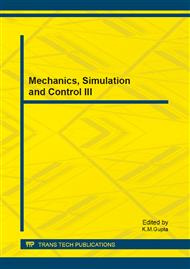[1]
Z. J. Jin, J. S. Weng, H. Y. Hu, Rollover Warning and Anti-Rollover Control for Automobiles, Journal of Dynamics and Control, vol. 5, No. 4, pp.365-369, (2007).
Google Scholar
[2]
X. K. Zhang, Vehicle Rollover Warning and Control Based on Rollover Position Monitor, Nanjing: Nanjing University of Aeronautics and Astronautics, (2007).
Google Scholar
[3]
S. Rakheja, A. Picht, Development of Directional Stability Criteria for an Early Warning Safety Device, SAE Paper No. 902265, (1990).
DOI: 10.4271/902265
Google Scholar
[4]
R. Strickland, H. McGee, Evaluation of Prototype Automatic Truck Rollover Warning Systems, FHWA-RD-97-124, (1997).
Google Scholar
[5]
B. Johansson, M. Gafvert. Untripped SUV Rollover Detection and Prevention, 43rd IEEE Conference on Decision and Control, Nassau, vol. 2, pp.5461-5466, (2004).
DOI: 10.1109/cdc.2004.1429677
Google Scholar
[6]
S. B. CHOI, Practical Vehicle Rollover Avoidance Control Using Energy Method, Vehicle System Dynamics, vol. 46, No. 4, pp.323-337, (2008).
DOI: 10.1080/00423110701377109
Google Scholar
[7]
B. C. Chen, H. Peng, Rollover Warning for Articulated Heavy Vehicles Based on a Time-to-rollover Metric, Transaction of the ASME, vol. 127, No. 9, pp.406-414, (2005).
DOI: 10.1115/1.1988340
Google Scholar
[8]
R. W. Goldman, Development of a Rollover-Warning Device for Road Vehicles, Pennsylvania : Pennsylvania State University, (2001).
Google Scholar
[9]
H. Imine, V. Dolcemascolo, Rollover risk prediction of heavy vehicle in interaction with infrastructure, International Journal of Heavy Vehicle Systems, vol. 14, No. 3, pp.294-307, (2007).
DOI: 10.1504/ijhvs.2007.015605
Google Scholar
[10]
H. Shraim, M. Ouladsine, L. Fridman, and M. Romero, Vehicle parameter estimation and stability enhancement using sliding modes techniques, International Journal of Vehicle Design, Vol. 48, No. 3/4, pp.230-254, (2008).
DOI: 10.1504/ijvd.2008.022578
Google Scholar
[11]
J. Hall, J. Magraw, Modeling Vehicle Rollover, The Physics Teacher, vol. 43, No. 6, pp.51-53, (2005).
Google Scholar
[12]
R. J. Whitehead, A Study of the Properties that Influence Vehicle Rollover Propensity, Aubum: Auburn University, (2005).
Google Scholar
[13]
X. P. Du, H. M. Sun, K. Qian, Y. Li, and L. T. Lu, A Prediction Model for Vehicle Sideslip Angle based on Neural Network, 2rd IEEE International Conference on Information and Financial Engineering, Chongqing, China, pp.451-455, (2010).
DOI: 10.1109/icife.2010.5609398
Google Scholar
[14]
A. I. Belousov, S. A. Verzakov and J. von Frese, A flexible classification approach with optimal generalisation performance: support vector machines, Chemometrics and Intelligent Laboratory Systems, vol. 64, No. 1, pp.15-25, (2002).
DOI: 10.1016/s0169-7439(02)00046-1
Google Scholar


